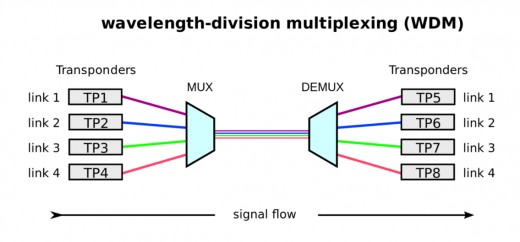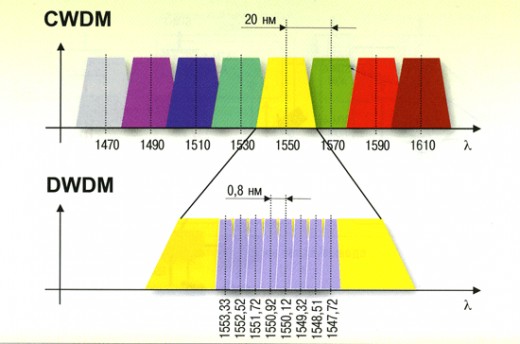Overview of CWDM vs DWDM
As we know, WDM (wavelength-division multiplexing) is a technology that can multiplex a number of optical carrier signals into a single optical fiber by using different wavelengths of laser light. Since there is a tremendous demand for high bandwidth, WDM becomes popular in the market. There are two key types of WDM technologies: CWDM (coarse wavelength division multiplexing) and DWDM (dense wavelength division multiplexing). Then, what are they? What’s the difference between them? This article will have a brief overview of CWDM vs DWDM to help you understand the differences between CWDM and DWDM technology.

What Is CWDM Technology?
CWDM (coarse wavelength division multiplexing) is a wavelength multiplexing technology for cities and access networks. The word “coarse” means the wavelength spacing between channels is relatively large. In general, CWDM has 18 different channels with a wavelength range from 1270 nm to 1610 nm. Because of the high data rates and low cost, CWDM is widely used in large campuses and data centers. Hence, it has become the preferred method for increasing the bandwidth of metro and optical access networks at a low cost.

What Is DWDM Technology?
DWDM is an optical multiplexing technology used in fiber optics to increase the bandwidth, which resembles CWDM technology. The word “dense” here means the wavelength channels are very close to each other. According to ITU regulations, DWDM has 100GHz (0.8nm) wavelength spacing for 40 channels or 50GHz (0.4nm) spacing for 80 channels. Because of its ability to handle so much data, DWDM is widely used in telecommunications and cable companies and becomes an integral part of their core networks gradually.

CWDM vs DWDM: What Are Their Differences?
Both CWDM and DWDM use multiplexed wavelengths of laser light to increase bandwidth capacity. However, they still have a lot of differences given the following aspects: channel spacing, transmission distance, modulation laser and cost. Just read on to find the details.
Channel Spacing
From the words “coarse” and “dense”, we can see the difference in channel spacing that CWDM has a wider spacing than DWDM. CWDM can provide 18 wavelengths (from 1270 nm to 1610 nm) with the channel spacing of 20 nm. While DWDM can carry 40, 80 or even 160 wavelengths (from 1563.86 nm to 1528.77 nm) with a narrow wavelength spacing of only 1.6, 0.8 or even 0.4 nm. It is simple to see that DWDM has a better performance than CWDM when transmitting a greater number of multiplexed wavelengths on a singer fiber.

Transmission Distance
DWDM technology is able to have a long transmission by keeping the wavelength highly integrated. The amplified wavelengths can make DWDM suffer less interference over a larger run of cable. Unlike DWDM technology, CWDM can’t travel unlimited distance as the wavelengths are not amplified. Usually, CWDM can transmit data up to 160 km.
Modulation Laser
DWDM technology uses the cooling laser, which is a technology that atomic and molecular samples can be cooled down to near absolute zero. Conversely, CWDM technology uses the uncooled laser, which can’t ensure better performance, higher safety, and long life span like DWDM.
Cost
Generally, the price of DWDM is four or five times higher than that of CWDM. The higher cost of DWDM mainly contributes to cooling laser technique which can realize the temperature tuning. But nowadays, as DWDM technology becomes more and more popular, the price of DWDM transceiver becomes cheaper than CWDM transceiver.
A detailed comparison between CWDM and DWDM technology is in the table below.

Conclusion
From the introduction of CWDM vs DWDM, we know that CWDM and DWDM are two technologies based on WDM technology with different wavelength patterns and applications. Usually, CWDM costs less and its performance is far behind DWDM. Both the cost and requirement should be taken into consideration. You’d better think twice before choosing a CWDM or DWDM system.



